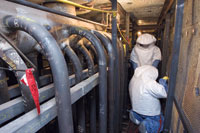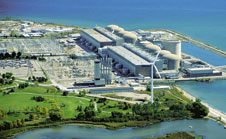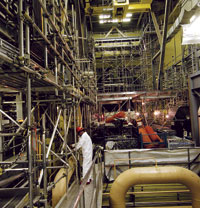 |
| Tight Spot. 60% of the work was done in radiation suits, often in cramped spaces. |
Pickering A Nuclear Generating Station Unit 1 went critical at 10:05 p.m., Aug. 2, on schedule and within its $825-million budget. The achievement was the culmination of a struggle with history. As the second unit returned to service since all four of the plants units were laid up in 1997, the successful restart eclipsed the owners earlier and near-disastrous effort to bring back the plants fourth unit and may foretell a rejuvenation of nuclear power generation in energy-starved Ontario. Already, Ontario Power Generation Inc., the operator, is considering whether to request permission to restart Pickerings other units. Industry observers say its chances of success are good.
The plants eight 515-MW units sit beside Lake Ontario in the town of Pickering, just east of Toronto. Pickering As four units were constructed by Ontario Hydro Construction and Atomic Energy of Canada Ltd. and went into service in 1971. Its reactors were among the first generation of CANDU (Canadian Deuterium Uranium) reactors built.
 |
| Lakeside Site. Pickering A (Click here to view illustration) comprises four 515-MW reactors constructed in 1971, with Pickering B added in 1983. |
The CANDU reactor uses natural uranium (U-238) for fuel and heavy water to moderate the fission reaction and as the process fluid to transport heat to the steam generators. Steam from there is expanded across turbines in a hall outside the reactor containment building to generate electricity.
In 1997, "performance issues" led to a reassessment of the 20-unit nuclear program at OPGs predecessor, Ontario Hydro, says Bill Robinson, OPG senior vice president. "All of the units were suffering some operational problemsforced outages, low capacity factors," he says. "The nuclear program needed a lot of work. We lacked the resources to focus on 20 units, so we decided to focus attention on upgrading programs and processes." The company shut down its eight oldest units, four of them at Pickering A, and focused on improving operation of the remaining 12.
 |
| Big Job. All three low-pressure turbine spindles, weighing 95 tons each, were replaced for Unit 1 restart. |
The plan at the time was to restart the units at six-month intervals, but "there was insufficient understanding of the issues involved in bringing them back," Robinson says. That led OPG into costly mistakes in planning and preparation restart of Unit 4, the first to be attempted. Although Unit 4 was restarted in September 2003, provincial authorities furious over cost and schedule overruns seized OPG, fired its three top executives and ordered a review of the companys operations (ENR 1/12/04 p. 14). The chief nuclear officer and the entire board of directors also were fired.
| Related Links |
| With Lessons Learned on Two Restarts Third Times a Charm Utilities Dig In To Make Nuclear Plants Work Harder After Complete Makeovers |
The memory of that trauma has driven the Unit 1 restart team. "The experience with 4 showed where the problems were and gave us a roadmap to avoid them," says Robinson.
In March 2003, OPG engaged Chicago based Schiff Hardin LLP, a law firm with construction-industry expertise, to assist OPGs board of directors with forensic investigation of the Unit 4 debacle. Terry Murphy arrived at Pickering with Schiff Hardin in December 2003 as an advisor to OPGs acting return-to-service vice president and acting director of construction. A veteran contractor, he also was a pipefitter on nuclear powerplant projects in the 1970s.
In early February 2004, with the Unit 1 project at a critical point, OPG tapped him to replace the acting director of construction. OPGs decapitation had shattered morale within the utility and "the public had lost confidence in OPGs ability to build the project on time and on budget," says Murphy. "The government was ready to shut the plant down."
But Murphy recognized that "The people were not broken here." The challenge was to change behavior and make workers believe they could succeed. "The culture of the work force here has been the culture of, We can always do it tomorrow," says Dean Munsey, assistant construction director. People did their work until they found someone elses problem, adds Murphy. "We had to create a sense of urgency."
The attempt to turn the project around began Feb. 20, 2004, with a candid two-day review of the project led by an outside consultant. That meeting was crucial. "We identified the contractor players that were working through the process," says Murphy. As the facilitation proceeded, the contractors participation showed who was ready to commit to changeand who was not.
 |
 |
| Shore Enough. Work on major systems in boiler room (top) required 170 km of scaffolding while manufacturer overhauled three standby generators (above). |
Four weeks after that facilitation, OPG terminated Comstock Canada Ltd., the prime contractor left over from Unit 4. Comstock President Bob Quinn says OPG wanted a smaller contractor with a fresh outlook for the job.
Then, in one long weekend of nearly 100 hours of work, Murphy oversaw a "rebranding" of the entire site. Pickering staffers swept through the site, changing contractor locks to OPG locks and replacing contractor logos on toolboxes with OPG logos. "We turned it back into an OPG plant," Murphy says. "It looked different when the crews came back on Monday."
All trades people had been terminated for the change. Murphy asked Black & McDonald, Scarborough, Ontario, to expand its scope to serve as general services contractor. The company began rehiring trades people over the weekend. Black & McDonald went from being a minor contractor with 30% of the craft work force to the prime contractor, with 100%.
"The ramp-up was hard," says Larry Macdonald, vice president. Several major projects were competing for workers in the area and recruiting and training new workers could take two weeks to 30 days, he says.
Changes in contractors and culture had the desired effect. "Nobody believed wed take the biggest contractor off the site," says Murphy. "From that time forward, we gained a lot of respect from unions and contractors."
Complete Overhaul
Returning Unit 1 to service after a seven-year layup required upgrading and refurbishment of virtually every system. Originally expecting an early turnaround, OPG had left the fuel in the reactor. But many systems share the reactor building,...

Post a comment to this article
Report Abusive Comment